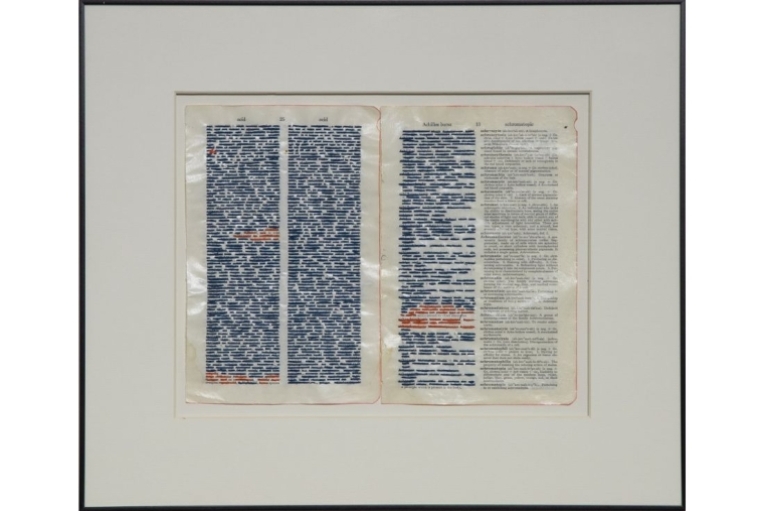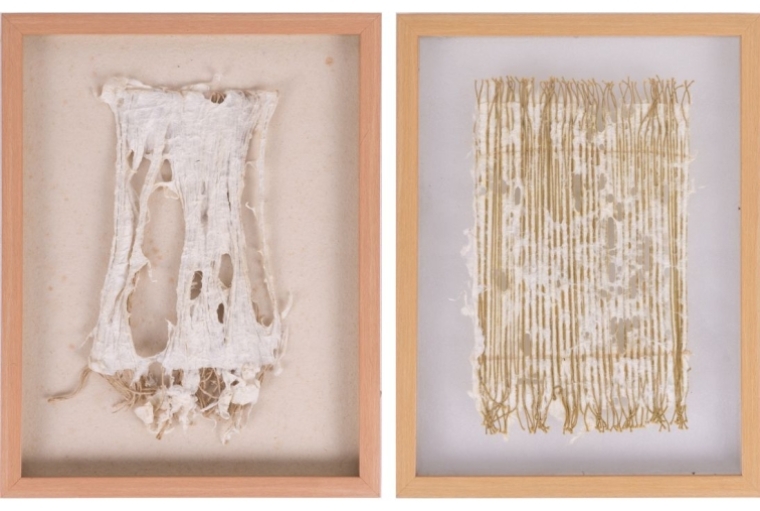
Devika Sundar - Essentially Normal Studies VII, Mixed Media on Backlit Plates, 16x9

Devika Sundar - Essentially Normal Studies VII, Mixed Media on Backlit Plates, 16x9
Arts have long played an integral part in how we teach, learn, communicate, and heal. Our earliest ancestors began telling stories to make sense of the world, and since then, humans have evolved to learn from narrative, be it through visual media or performances. The arts are uniquely suited to help us understand as well as communicate ideas by drawing on multiple senses. Further, Art can help us to emotionally navigate the journey of battling an illness or injury, to process difficult emotions in times of emergency, and challenging events. According to a study conducted by the World Health Organization, including the arts in health care delivery has been shown to support positive clinical outcomes for patients while also supporting other stakeholders, including health care providers, the patient’s loved ones and the wider community.
This exhibition brings together artists who reference deeply personal emotions originating from health conditions they are dealing with. Whether the process of creating supports in healing or it remains a way to express, be it a case of ‘art for art’s sake’ or a mode for increased awareness and empathy, the artists use their physical, physiological, or physiological conditions as the core source of inspiration. Mark making that measures a fluctuating rhythm, imagery that tells of dichotomies, or formats that evoke a sense of pain, the group of artists use various methodologies in their respective artistic journeys.
Avinash Veeraraghavan
Friction Fruit (diptych)
Juxtaposing patterns of media and transmission, while distinct, there is a moment of connection between the two components. The left panel captures that liminal space between media, where patterns exist but only come together when everything falls into place. Forming a core of expression, the markings showcase the manifestation of unconscious energy in real world narratives, storytelling and technology.The serpent, often used to represent desire, or the erotic slithers across a fixture of nature. This unconscious collective meets an immovable, tangible object and slowly swallows it whole, wrapping itself, consuming it as it moves upward.
The Cradle
A cradle plays an interesting part in the development of the human psyche. In the early part of life, it forms the entirety of the universe, the bedrock of experience, emotions, and even existence. Composed of a jali pattern that has been contorted, remixed, and reimagined, the image in The Cradle, revealed through the pattern is that of a sinkhole. The work focuses on the moment when the center can no longer hold, representing the collapse of reality, when things fall apart.
Bakula Nayak
When Pittsburgh based artist Bakula Nayak began painting in 2013 she was at a critical juncture in her life, having to give up a successful communications design career and begin a decade long journey of living with chronic pain. Nayak’s art is autobiographical and her practice cathartic, a way to communicate this ordeal with the world.
The cornerstone of her art practice is storytelling. She weaves together her own personal experiences with those of others by layering once-functional discarded papers with symbolic renditions of a proactive and reactive mind. While her work on vintage paper is a mainstay of her profound approach to re-contextualizing human experiences, her multiple philosophical expressions branch out diversely in search of an invented visual vocabulary to support them. She explores themes of synergy between the individual and the collective, processes of art and meaning-making, the experiences of women as well as contemporary cultural and psycho- social situations. The centrality of the female form in her art points to the complicated relationship Nayak has with her physical being, the struggles between the outward appearance of normality and the internal management of the hidden, elusive qualities of pain. A central narrative in Nayak’s work is that this experience is hidden, invisible and difficult to understand.

Bakula Nayak - To exist as a complex species , 2024, Needlework on vintage paper, 10 x 13 in
Devika Sundar
Essentially normal studies
Diagnosed with indications of fibromyalgia led to organizing, archiving, and tracking tests and symptoms across dates and files meant inevitably learning to play detective with my own body. Living with hidden illness accompanies with it a strange experience of dissonance between a visible seemingly able, ‘normal’ self and the invisibility of a disabling physical condition. Examining 8 years of diagnostic medical reports and scans, I screen and trace conflicts of invisibility, physicality and bodily experience; researching a medical environment that relies heavily on standardized scanning and testing, and examining the justification of definitive visible markers in diagnosing complex invisible illnesses.
A clean sterile dark sheet of film exposed against light. The hollowness of something absent, an escaped imperceptible layer ghosted against the sheet. Churned, typed words glide and float across the screen. ‘Normal, normal normal.’ Definitive, declarative, decisive. Unblemished by complication.
Khushbu Patel
Memory stains
During my journey of healing from trauma, I encountered a profound disconnection from my surroundings, engulfed by a constant stream of thoughts that kept me trapped within my own mind. The weight of the past bore heavily upon me, clouding my perception and distancing me from the present moment. It was a tumultuous time, marked by anxiety and a sense of alienation from the world around me. In the depths of this turmoil, I sought refuge in a simple yet transformative practice: painting the nature outside my window. While painting, I embarked on a journey of self-discovery, using art as a means to reconnect with the tranquility surrounded me. To engage in this process became a declaration of my presence, a conscious effort to break free from the chains of my own thoughts and immerse myself fully in the here and now. Through the act of observation and painting, I became an active participant, attuned to the ebb and flow of existence. In the quietude of creation, I discovered a sanctuary - a space where the boundaries between self and surroundings dissolved and I found myself within nature. In this process of making, I felt the weight of my burdens lift, replaced by a profound sense of peace and restoration. This works became a mirror reflecting not only the world outside but also the resilience and strength that resided within me.
Through my art, I aim to underscore the significance of observing overlooked spaces and exposing hidden marks. Similarly, I explore microscopic views of body marks, delving into the intricacies of my scalp, body, and skin. These intimate explorations reveal a hidden paradise world inaccessible to the naked eye. Each mark tells a story, unveiling a secret life shared with both myself and the spectators who peer closely. They strain to follow the intricate routes I have created within each artwork, as if uncovering a hidden narrative
Neerja Kothari
202, 054
My work revolves around the act of quantifying my own muscle movements and making a narrative out of the marks that emerge. For this particular work I was thinking of muscle mass and the interruptions caused by the little pain knots that form on the myofascial layer. I go about marking each line that almost represents the facial bands and then the blue dots are put after every approximately 100 marks. The blue dots are symbols of, both, keeping track of the lines as also little nodules that interrupt the flow. Bruised and tiny and blue, they seem to be mathematical as well as musical notation when viewed on the paper. The 11 sheets are continuous and put one after the other like a long sentence.

Neerja Kothari - 202,045, 12_ x 9_ each (set of 11), Ink and colour pencil on paper, 2024
Priya Ravish Mehra
On loan from Kiran Nadar Museum of Art
In Visible Company
Artist Priya Ravish Mehra, who has spent years researching the role of darners in Indian textile and removed the veil of obscurity through her practice, talks to us about why making the invisible visible is a way to appreciate the imperfection of perfection.
I first saw the works of Priya Ravish Mehra at Gallery Threshold in New Delhi, with the display mostly comprising of her new mixed-media works that marked a departure, both aesthetic and conceptual, in her practice as a tapestry weaver. It was an intriguing body of work and in my desire to know more about her practice I visited one of her baithaks with darners. It felt like a homage to these neglected and anonymous artisans whose contribution to the protection of the treasury of Indian culture has not been acknowledged in the textile narrative. The darners at the event sat on the ground with a table lamp focused on the cloth they were meticulously working on. 'Darners have existed since mankind has known cloth. It is important to understand and accept the fact that the birth of cloth on a loom will always have defects. And it is the darners who correct this defect. They make the cloth "perfect". Such an irony then that the one who makes imperfections invisible must remain invisible himself, says Priya.
Priya's love for Indian textile emerges from her upbringing. Both her parents were artists and they studied at Shantiniketan. 'I don't think I "admired" art as a child; it was just part of everyday life. Right from the table and bed linen to pichchwai on walls, Gujarati toran on doors, they were all normal and not really seen as anything special or extraordinary. The distinction between art, craft and design did not exist for me. My grandparents lived in Najibabad in Uttar Pradesh. It is a region where traditional and professional darners lived in nearby villages. Historically, the town served as a hub of the shawl trade in North India for over 250 years. They would collect old pieces of textiles for repair: And because my parents had a particular interest in textiles, it was natural for them to engage with the visiting darners, talking about pieces of cloths, embroidery and weaves, their origin and application. Others would go to museums, and here we were with the museum coming right to our home!' she says.
The day we had fixed up to meet, I received a text requesting a change in time. In a curious coincidence, that morning Priya had to attend the funeral of Martand Singh, the man who championed the cause of Indian textiles and was a mentor to her Saris of India Project.
In fact, a significant part of her work has revolved around researching and documenting the process of darning. It is a trenchant paradox that Priya was given a few months, but twelve years post-diagnosis, she continues to fight cancer and her research work remains a significant source that provides new meaning for her.

Priya Ravish Mehra
Words Rahul Kumar
Date 09.08.2024